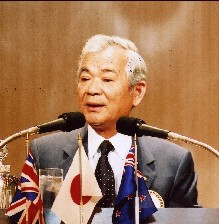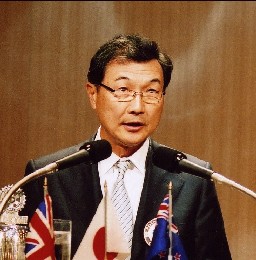Initiation Speech
May 24, 2006
Mr. Haruyuki Niimi
Mr. Fumio Nagase
 ��Talk about Oil, a bit of This and That��
��Talk about Oil, a bit of This and That��
Mr. Haruyuki Niimi,
Chairman and Representative Director,
SHOWA SHELL SEKIYU K.K.
(1)Japan is the 3rd biggest oil-consuming country in the world.
��The world��s biggest oil-consuming country is the U.S. Its total yearly consumption amounts to one 1 billion kiloliters, which is about one-fourth of the total world consumption of oil. Coming after the U.S. is China, which consumes 0.29 billion kiloliters, and then Japan, 0.28 billion kiloliter. A little less than one-half of the Japanese primary energy supply depends on oil. A calculation result shows that a Japanese per capita daily oil consumption is a little below 7 liters.
(2) History of oil
Oil products having been seen around the time when Rising Son Oil, a Showa Shell Sekiyu��s predecessor was established in 1900, were candles and kerosene, and the latter was used also for pesticides. The time when the Japanese navy began to use oil was at the end stage of the Meiji era, and all of the previous fuel had been coal. The volume of the oil supply jumped to the top position, surpassing the coal supply for the first time, in 1962. In the same year, the Petroleum Industry Law was enacted and the oil industry was placed under government control.
(3) Global environmental issue and oil
Although Japan is a top-level energy-saving country, it is extremely difficult to achieve the emissions-reduction target determined by the Kyoto Protocol.
��Having been a focus of attention as the next energy following oil is natural gas. Greenhouse gas emissions of LNG are about 80 percent that of oil, and so it is effective in reducing gas emissions. Greenhouse gas emissions by types of cars is calculated as follows, with one hundred 100 percentage points representing that of a gasoline-powered car: (i) diesel-powered cars; seventy-five 75 percent, (ii) hybrid cars; fifty 50 percent, and (iii) cars powered by fuel batteries; sixty 60 percent. Further improvement in energy efficiency and cost-down are expected to be achieved by technical innovation. Although solar light and wind power are renewable energy sources, the pace of their diffusion is rather slow, because their power generating costs are high.
��We reaffirmed our determination to work hard on energy-saving activities and new energy development, to make efforts to enhance consumers�� desire for environment protection, and to make today��s oil industry continue to be the one, which is highly evaluated by the society.
 ��Movie Situations in Japan��
��Movie Situations in Japan��
Mr. Fumio Nagase,
Director and President,
IMAGICA Corp.
��A predecessor of IMAGICA Corp is ��Toyo Processing Station��, which was founded in 1935. At present, it engages in the production of movies, TV programs, and TV commercial films.
��
��In general, Japanese office workers barely go to movie theaters. To enjoy movies for real, there is no choice but to see them in one shot through a large screen, with wonderful sound, and in the darkness. Watching movies at a movie theater is highly recommended, rather than seeing them through television or DVDs.
��Let me talk about the situations of the movie industry both in Japan and the U.S. Domestic box-office revenue of the U.S. in the fiscal year of 2005 was about one trillion yen, and that of Japan was approximately 200 billion yen. If exports are included, that of the U.S. was two trillion yen.
��There are 37,740 movie theaters in the U.S., versus 2,936 in Japan. In simple comparison, the number of movie theaters in the U.S. is thirteen times that of Japan. The U.S. is in a more favorable situation than in Japan even with a difference in population being taken into consideration.
��There had once been 7,500 movie theaters in Japan in the 1960s, a golden age of Japanese cinema. The number fell down to a record low of 1,700 in 1993, but it has recovered to about 3,000 thanks to the emergence of American-type cinema complexes.
��The number of spectators in the U.S. in a year was 1,400 million and that in Japan was 160 million, which means that one person in the U.S. visited cinema theaters 4.8 times a year, on average, versus 1.3 times in Japan.
��I had lived in Westwood, Los Angeles, for two years in the past. I saw many people getting lined up in front of a first running theater of a new movie on Friday evening. Movies seen at a weekend often become a popular topic of conversation at offices in the following Monday morning.
��A movie titled ��The Da Vinci Code��, simultaneously released in the world in the last weekend, is said to become a hit film without fail. A film by the title of ��Always 3-Chome��s Sunset��, that won this year��s Academia Prize, is Japan��s good piece of work. The number of movies, which are popular among middle-aged and older people is also increasing. I hope that the day will come again, even in Japan, when movie theaters are full of old and young people on Saturday afternoon.